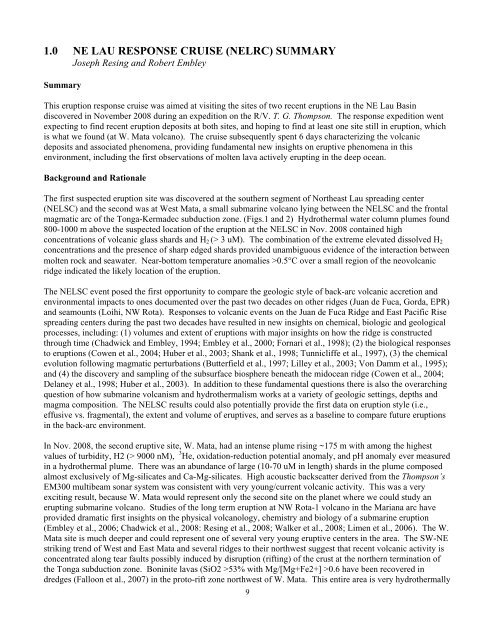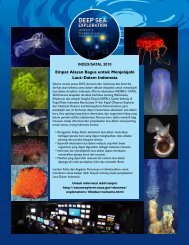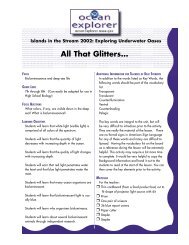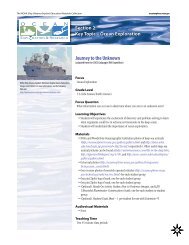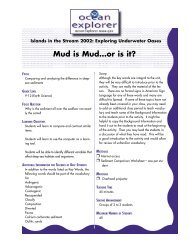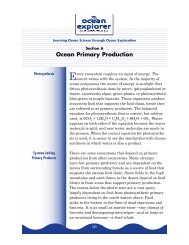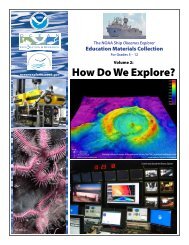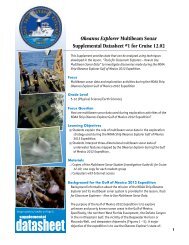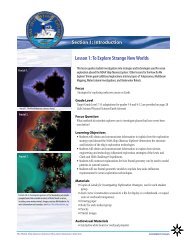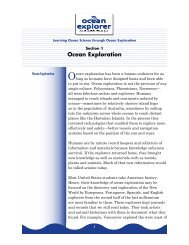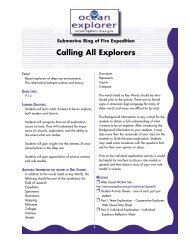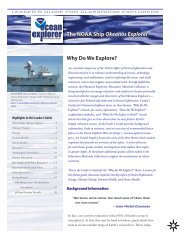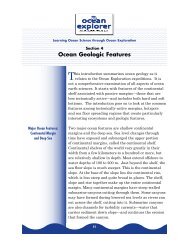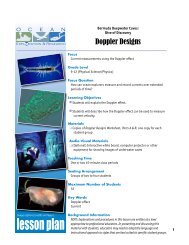Cruise Report (PDF, 4.8Mb) - NOAA, Ocean Explorer
Cruise Report (PDF, 4.8Mb) - NOAA, Ocean Explorer
Cruise Report (PDF, 4.8Mb) - NOAA, Ocean Explorer
Create successful ePaper yourself
Turn your PDF publications into a flip-book with our unique Google optimized e-Paper software.
1.0 NE LAU RESPONSE CRUISE (NELRC) SUMMARY<br />
Joseph Resing and Robert Embley<br />
Summary<br />
This eruption response cruise was aimed at visiting the sites of two recent eruptions in the NE Lau Basin<br />
discovered in November 2008 during an expedition on the R/V. T. G. Thompson. The response expedition went<br />
expecting to find recent eruption deposits at both sites, and hoping to find at least one site still in eruption, which<br />
is what we found (at W. Mata volcano). The cruise subsequently spent 6 days characterizing the volcanic<br />
deposits and associated phenomena, providing fundamental new insights on eruptive phenomena in this<br />
environment, including the first observations of molten lava actively erupting in the deep ocean.<br />
Background and Rationale<br />
The first suspected eruption site was discovered at the southern segment of Northeast Lau spreading center<br />
(NELSC) and the second was at West Mata, a small submarine volcano lying between the NELSC and the frontal<br />
magmatic arc of the Tonga-Kermadec subduction zone. (Figs.1 and 2) Hydrothermal water column plumes found<br />
800-1000 m above the suspected location of the eruption at the NELSC in Nov. 2008 contained high<br />
concentrations of volcanic glass shards and H2 (> 3 uM). The combination of the extreme elevated dissolved H2<br />
concentrations and the presence of sharp edged shards provided unambiguous evidence of the interaction between<br />
molten rock and seawater. Near-bottom temperature anomalies >0.5°C over a small region of the neovolcanic<br />
ridge indicated the likely location of the eruption.<br />
The NELSC event posed the first opportunity to compare the geologic style of back-arc volcanic accretion and<br />
environmental impacts to ones documented over the past two decades on other ridges (Juan de Fuca, Gorda, EPR)<br />
and seamounts (Loihi, NW Rota). Responses to volcanic events on the Juan de Fuca Ridge and East Pacific Rise<br />
spreading centers during the past two decades have resulted in new insights on chemical, biologic and geological<br />
processes, including: (1) volumes and extent of eruptions with major insights on how the ridge is constructed<br />
through time (Chadwick and Embley, 1994; Embley et al., 2000; Fornari et al., 1998); (2) the biological responses<br />
to eruptions (Cowen et al., 2004; Huber et al., 2003; Shank et al., 1998; Tunnicliffe et al., 1997), (3) the chemical<br />
evolution following magmatic perturbations (Butterfield et al., 1997; Lilley et al., 2003; Von Damm et al., 1995);<br />
and (4) the discovery and sampling of the subsurface biosphere beneath the midocean ridge (Cowen et al., 2004;<br />
Delaney et al., 1998; Huber et al., 2003). In addition to these fundamental questions there is also the overarching<br />
question of how submarine volcanism and hydrothermalism works at a variety of geologic settings, depths and<br />
magma composition. The NELSC results could also potentially provide the first data on eruption style (i.e.,<br />
effusive vs. fragmental), the extent and volume of eruptives, and serves as a baseline to compare future eruptions<br />
in the back-arc environment.<br />
In Nov. 2008, the second eruptive site, W. Mata, had an intense plume rising ~175 m with among the highest<br />
values of turbidity, H2 (> 9000 nM), 3 He, oxidation-reduction potential anomaly, and pH anomaly ever measured<br />
in a hydrothermal plume. There was an abundance of large (10-70 uM in length) shards in the plume composed<br />
almost exclusively of Mg-silicates and Ca-Mg-silicates. High acoustic backscatter derived from the Thompson’s<br />
EM300 multibeam sonar system was consistent with very young/current volcanic activity. This was a very<br />
exciting result, because W. Mata would represent only the second site on the planet where we could study an<br />
erupting submarine volcano. Studies of the long term eruption at NW Rota-1 volcano in the Mariana arc have<br />
provided dramatic first insights on the physical volcanology, chemistry and biology of a submarine eruption<br />
(Embley et al., 2006; Chadwick et al., 2008: Resing et al., 2008; Walker et al., 2008; Limen et al., 2006). The W.<br />
Mata site is much deeper and could represent one of several very young eruptive centers in the area. The SW-NE<br />
striking trend of West and East Mata and several ridges to their northwest suggest that recent volcanic activity is<br />
concentrated along tear faults possibly induced by disruption (rifting) of the crust at the northern termination of<br />
the Tonga subduction zone. Boninite lavas (SiO2 >53% with Mg/[Mg+Fe2+] >0.6 have been recovered in<br />
dredges (Falloon et al., 2007) in the proto-rift zone northwest of W. Mata. This entire area is very hydrothermally<br />
9


